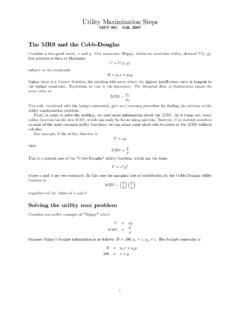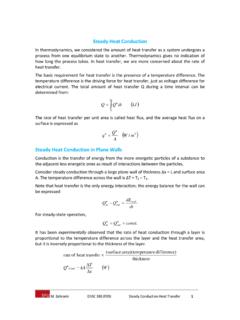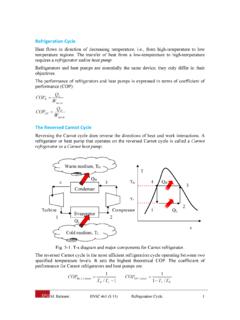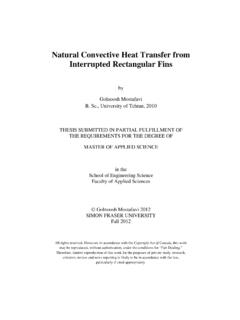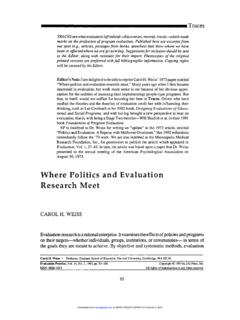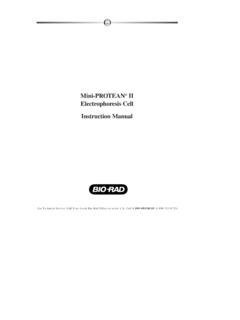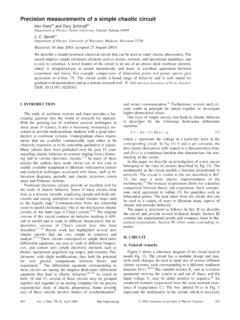Transcription of Example Term Paper Format - SFU.ca
1 Example Term Paper FormatECON 460 November 19, 2011 AbstractThe following Paper is an Example of the appropriate stlyle, layout andformat for an term Paper or essay in an economics course. All papers shouldhave a title page that contains the following:1. Title of the Paper2. Course Number and Instructor3. Your name and student number4. DateAny graphs should be on seperate pages that are not counted as part of thewritten page requirements. All graphs must be discussed and explained withinthe body of the and magazine articles may be cited but do not count as part ofthe required REVIEW OF FRANCHISE THEORYINTRODUCTIONIn service based industries one of the fastest growing forms of market structureis that of franchise agreements.
2 Certain aspects of franchise contracts tend to beidiosyncratic in nature thereby attracting a great deal of interest by academics andbusiness analysts in recent years. Various explanations have been proposed for thewidespread use of franchise contracts in certain industries. While a great deal of thefranchise contract has been explained in the literature, there remains certain aspectsof this form of arrangement that has yet to be addressed. This Paper intends toaddress two of these issues as well as proposing an alternative modelling approach tofranchise second section of this Paper describes the basic structure of franchise con-tracts. The third section discusses the various explanations that have been proposedto explain franchising.
3 The fourth section sets two aspects of the franchise contractthat has not been addressed in the literature. The rst of these is existence of bothcorporate owned outlets and franchised outlets within the same organization. Someauthors have predicted that one form or the other would come to dominate the or-ganization. Others have tried to explain under which conditions one form would bepreferred by the parent company (or Franchisor). Yet many organizations exist asa mixture of both types of contracts and have chosen both forms of contract whenexpanding the number of outlets. The second unexplained observation is apparentrigidity in various organizations franchise fee structure; both over time and betweenindividual franchisees.
4 This section introduces spatial or geographical considerationsto the problem of franchising. When placed in a spatial context a testable hypothesisis proposed in which both of the issues identi ed can be OF THE FRANCHISE CONTRACTA basic result derived in modern property rights literature is that when any givenset of rights is exchanged, the principals involved will select the institutional frame-work that minimizes the sum of production and transaction costs1. The most com-monly observed of these arrangements (or governance structures) are price mediatedmarkets and centralized employment within rms2. These are not the only forms ofarrangement within which transactions are carried out, and the distinction betweenthe two mentioned above is not as clear as it is suggested.
5 An Example of an alterna-tive institutional framework is a franchise arrangement, and the purpose of this paperis to analyze the nature and purpose of franchise a franchise contract, a parent company contracts out the right to produce ormarket its product to an agent. Contractual stipulations involve rules governing thebehavior of the agent including pricing, mode of production, and territorial or marketrestrictions. A frequently observed feature of a franchised industry is that certainaspects of the parent company s product have limited scale economies that requireproduction at the local market principle characteristic of franchise contracts is the agent s right to use a nationalbrand name in exchange for a share of the pro ts.
6 The brand name is a signal toconsumers in a local market that the agent supplies a product of a certain quality. Thee ectiveness of the brand name as a quality signal will decide its value to the nature of brand names and the characteristics of certain industries thatrely on them, franchise contracts as a form of governance structure may be the moste cient for enhancing and protecting the value of the brand , O. E., "Transaction Cost Economics: the Governance of Contractual Arrange-ments",The Journal of Law and Economics, 22, Oct. (1979) 223-2612 Cheung, "The Contractual Nature of the Firm,"The Journal of Law and Economics, 26 April (1983) contracts have certain common characteristics3. The franchisor sells orleases the right to produce or sell some product to a franchisee.
7 Written into thecontract are various obligations and commitments required by both , with the right to use the franchisor s brand name, the franchisor also agreesto supply various types of assistance. This includes orientation with the productionprocess, managerial and accounting assistance, site selection and development, andany ongoing assistance or advice, as required. The franchisor also takes responsibilityfor national marketing and advertising also any research and development of the prod-uct. Second, the franchisee agrees to operate the business in the manner stipulatedby the franchisor. This includes hours of operation, pricing scheme, inventory levels,and adherence to the operating manual if one is supplied.
8 Third, the franchiseeagrees to pay royalties to the franchisor. This is usually in the form of a non-linearoutlay schedule, comprised of a xed fee plus a share of the , there will be a monitoring and auditing clause in the contract. This may bespelled out explicitly, but will usually give the franchisor arbitrary and discretionarypower. Fifth, the contract will have a termination clause. The termination clausewill heavily favour the franchisor who can practically end at will. The franchisee, onthe other hand, also can terminate, but at unfavourable terms , usually incurring aheavy penalty. Finally, the contract will contain miscellaneous clauses dealing withsale of the franchise, rights of heirs, territorial restrictions and any other conditionsthat may be speci c to the particular , for Example , Rubin, P.
9 "The Theory of the Firm and the Structure of the Franchise Con-tract,"Journal of Law and Economics, 21 (1978) 223-233; or Caves, and Murphy, "Fran-chising: Firms, Markets and Intangible Assets,"Southern Economic Journal, 42 (1976)4 EXPLANATIONS OF FRANCHISINGF ranchising As a Method of Capital accumulationIt was believed that franchising rst arose as a form of capital accumulation andrapid expansion4. This line of reasoning can be discredited on two accounts. First, ifan individual is to buy a franchise, he bears all the risk (uncertainty of the residualclaim) of that one outlet, whereas the franchisor has his risk spread across all bear this higher risk, a risk averse franchisee will demand a higher risk premium(share of the pro ts).
10 The franchisor could therefore put together a package of sharesfrom all the outlets, and sell them to the individual store managers. The franchisorthus lowers the risk premium he must pay while maintaining full control of the the less costly arrangement, this form of organization will , franchisees tend to have little or zero wealth. Therefore, the funds theyinvest in a franchise must be acquired. With imperfect capital markets, it is unlikelythat an individual would be more successful at raising the needed capital than analready established rm. Therefore, capital accumulation is not an adequate expla-nation of to Ensure Agent ComplianceA brand name is a mechanism by which certain measures (but not usually all)may be foregone6.
